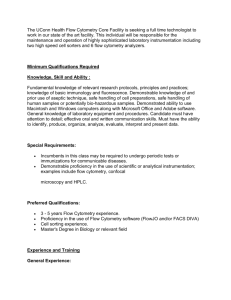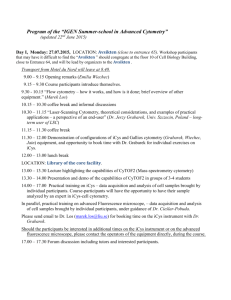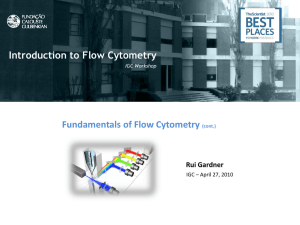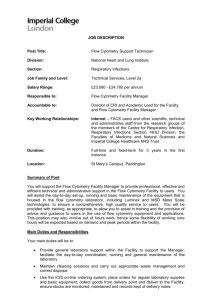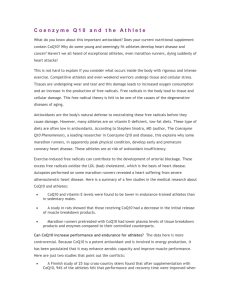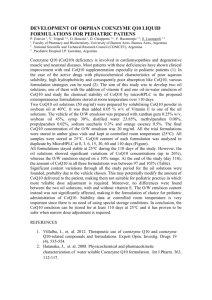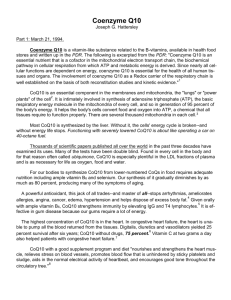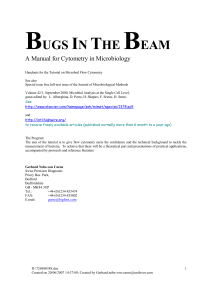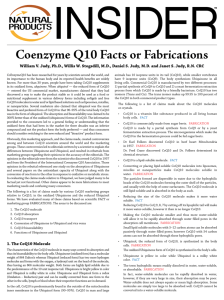Measuring Leukocyte Mitochondrial Superoxide Using Flow Cytometry
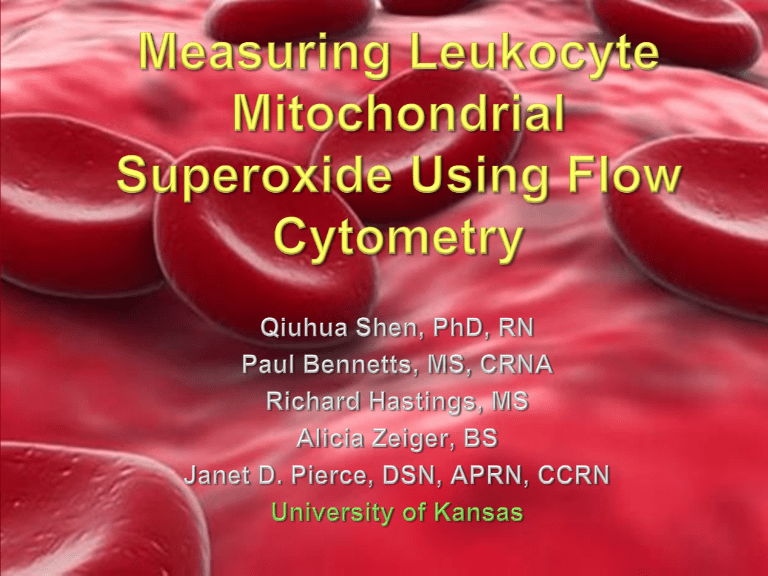
Reactive Oxygen Species (ROS)
Highly reactive molecules containing oxygen and unpaired electrons, which are byproducts of oxidative phosphorylation in mitochondria
Three major types of reactive oxygen species
(ROS)
Superoxide (O
2
) – relatively long half life
Hydrogen Peroxide (H
2
O
2
)
Hydroxyl free radical (OH ) – very active oxidant
Increase in cellular ROS can cause oxidative damage to lipids, DNA , and protein
Mitochondrion and ROS
Electron Transport Chain: Complexes I-V
Measurement of ROS
Significance of measuring of ROS
Evaluate oxidative stress status
Assess effectiveness of treatment
Challenging due to the instability of ROS
Currently available methods:
Lipid peroxidation assay
Electron spin resonance
Image analysis-based fluorescence microscopy
Flow cytometry
Flow Cytometry
What is flow cyto metry ?
Flow = cells are in motion
Cyto = cells
Metry = measure
Flow cytometry = measuring characteristics/ properties of cells while they are in a fluid stream
Laser-based, biophysical technology
Can simultaneously analyze multiple physical and/or chemical characteristics of thousands of cells per second
Mechanism of Flow Cytometry
BD LSRII Flow Cytometer
Aim
Methods
Hemorrhagic shock rat model
Removal of 40% of blood volume from anesthetized rats over one hour
Fluid resuscitation with/without Coenzyme Q10
Coenzyme Q10 is a key component in the electron transport chain in mitochondria and plays roles in ATP production and scavenging ROS
Hypoperfusion and reperfusion injury cause increases in ROS production
Experimental Design
120
70
S1
Hemorrhagic Shock
1 hour
S2
S4
2 hours
S5
Stages of the Experiment
Reagents
Monoclonal antibodies (CD45) – leukocytes
MitoSOX Red (Molecular Probes, Invitrogen)
A novel fluorogenic dye
Highly selective detection of superoxide in the mitochondria of live cells
Exhibits red fluorescence when oxidized by superoxide.
Methods
Blood samples (0.1 ml) were collected at baseline, shock, and after fluid resuscitation with or without intravenous
Coenzyme Q10.
Unstained and single stained controls were obtained at baseline.
20 µl of blood were incubated with 2 µl
CD45 in 200 µl of phosphate buffered saline (PBS) for 5 minutes at 37 0 C.
1 ml of MitoSOX Red solution was added to the blood sample and incubated in the dark for 30 minutes at 37 0 C
Methods
1 ml of PBS was added after incubation and then centrifuged at 1000 rpm for 5 minutes
Supernatant was disregarded and the pellet cells were then suspended in 1 ml of
PBS.
Methods
Three analyses with 10,000 leukocytes
(CD45 positive cells) were conducted using flow cytometry (Becton Dickinson LSRII) for each sampling period
Mean fluorescence intensity (MFI) of MitoSOX
Red was obtained
Data Acquisition and Analysis
MFI = 6782
Baseline
MFI = 4104
Shock
MFI = 9684
MFI = 3367
Treatment with CoQ10 Treatment without CoQ10
Results
Mean Fluorescence Intensity of MitoSox Red at baseline, shock and after fluid resuscitation
Baseline
No CoQ10
5904 ± 245
CoQ10
5848 ± 327
Shock 6943 ± 210 6786 ± 502
Treatment 7992 ± 698 * 5469 ± 529
2000
1000
0
5000
4000
3000
9000
8000
7000
6000
Baseline
Results
Shock Treatment
No CoQ10
CoQ10
Lessons Learned
Sample preparation in the dark !!
MitoSOX Red is very sensitive to light exposure
Wash cells is an important step to remove excessive unbound monoclonal antibodies to avoid background fluorescence
Running samples on time
Conclusions
Research Team
Dr. Janet Pierce, PI
Dr. Richard Clancy, grant consultant
Paul Bennetts, doctoral student
Amanda Thimmesch, Research Associate
Flow Cytometry Center, University of
Kansas Medical Center
Richard Hastings
Alicia Zeiger
Acknowledgement
This research was sponsored by the
TriService Nursing Research Program ,
Uniformed Services University of the Health
Sciences (HU0001-11-1-TS09).
This presentation was supported partially by the Postdoc Travel Scholarship funded by the
KU Hospital Auxiliary and Faculty Travel
Fund by the Office of Grant and Research
(OGR) , School of Nursing, University of
Kansas

